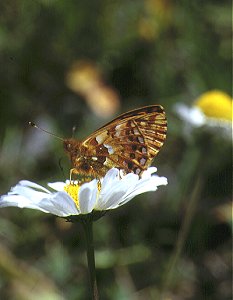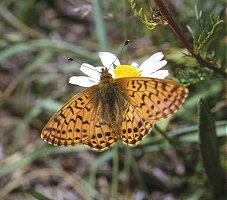Exact publication to the actually published paper: Kosterin, O. E. 2000. Description of a new subspecies of the Boloria pales ([Denis et Schiffermuller], 1775) sensu Warren (1944) (Lepidoptera, Nymphalidae) from Altai. Far East Entomologist (Vladivostok) 86: 1-10.
NOTE: There was some, although very minor, editorial revision which I cannot accept (some modification of the sense and spelling errors were introduced). Here the original version is presented. In the publication the figures were in black-and-white. Here I present coloured figures and add two more figures (Figs. 4 and 5) which were not included into the publication.
DESCRIPTION OF A NEW SUBSPECIES OF THE BOLORIA PALES ([DENIS ET SCHIFFERMULLER], 1775) SENSU WARREN (1944) (LEPIDOPTERA, NYMPHALIDAE) FROM ALTAI
O. E. Kosterin
Institute of Cytology & Genetics of SB RAS, Novosibirsk 630090, Russia
Boloria pales roddi ssp. n. is described from Central, South- East and South-West Altai, which is most close to B. pales banghaasi Seitz, 1909.
KEYWORDS: Lepidoptera, Nymphalidae, Russia, taxonomy.
Î. Ý. Êîñòåðèí. Îïèñàíèå íîâîãî ïîäâèäà Boloria pales ([Denis et Schiffermüller], 1775) sensu Warren (1944) (Lepidoptera, Nymphalidae) ñ Àëòàÿ. // Äàëüíåâîñòî÷íûé ýíòîìîëîã. 2000. N 86. C. 1-10.
Èç Þãî-Âîñòî÷íîãî, Þãî-Çàïàäíîãî è Öåíòðàëüíîãî Àëòàÿ îïèñûâàåòñÿ íîâûé ïîäâèä Boloria pales roddi ssp. n., íàèáîëåå áëèçêèé ê B. pales banghaasi Seitz, 1909.
Èíñòèòóò öèòîëîãèè è ãåíåòèêè ÑÎ ÐÀÍ, ïð. àêàä. Ëàâðåíòüåâà 10, Íîâîñèáèðñê, 630090. Ðîññèÿ.
INTRODUCTION
The genus Boloria Moore, 1900 s.str., although apparently embracing few species, presents enormous taxonomic problems as being represented by a number of mostly allopatric taxa confined to different mountain systems, which exhibit rather a great geographical variation accompanied with a considerable individual variability. In his classical work, Warren (1944) has divided all the diversity of the genus into three species, the main diagnostic features being the ratio of the toothed apical part (head) of the harpe to the total harpe length, being 0.30-0.4 (with the mean 0.33) in B. graeca (Staudinger, 1870), 0.33-0.50 (with the mean of 0.40) in B. pales ([Denis et Schiffermuller], 1775) s.l., and 0.47-0.63 (with the mean of 0.50) in B. napaea (Hoffmannsegg, 1804) s.l. Although this value in different species in some cases may even overlap to a minor extent, this quantitative trait appears to be surprisingly stable and reliable. Other genitalia characters are very similar, except for a decreased aedeagus and disproportionally reduced wings of the phallobase in B. graeca. There is some other differences, e. g. ventral curvature of the toothed head of the harpe, which are of little relevance as variable individually. Later Boloria napaea s.l. and Boloria pales s.l. were subdivided into a number of species each. (Warren, 1944) As to the group B. napaea s.l.,at present there are convincing evidences that it embraces at least three good species, while splitting of the B. pales s.l. group is more problematic.
In 1986-1987 on the Katunskii Range of the Altai Mts. I have collected a series of the Boloria s.str. butterflies apparently belonging to the superspecies Boloria (pales) s.l. which well distinguished from B. aquilonaris (Stichel, 1908), the only reported for Altai so far representative of this superspecies (Elwes, 1899; Lukhtanov & Lukhtanov, 1994), as well as from B. banghaasi (Seitz, 1909) known from the mountains of Central and East Siberia (Crosson, 1982; Korshunov & Gorbunov, 1995). These butterflies were described in my paper devoted to the butterflies of the Katunskii Range (Kosterin, 1994), but not named, as their taxonomic position remained unclear to me. Later these butterflies were collected in South-East Altai by a number of persons but have not been described yet. In this paper I give description of a new subspecies. The holotype, allotype, and a part of the paratypes are preserved in Siberian Zoological Museum at Institute of Systamatics and Ecology of Animals, Siberian Division of the Russian Academy of Sciences (Novosibirsk), other paratypes are in the personal collections by V. Ivonin and R. Yakovlev.
Since the new subspecies seems to represent a link between North Asiatic and Central Asiatic taxa, I can’t help but come back to the Warren’s (1944) notion of the limits of the species B. pales as embracing a lowland peat-bog inhabiting taxa B. pales aquilonaris (Stichel, 1908), B. pales alethea (Hemming, 1934) and B. pales neopales (Nakahara, 1926), and a great number of local mountain forms spread over Eurasia. Hence I do not adopt a species rank for the taxa relevant to considering the taxonomic position of the new taxon, namely, aquilonaris (Stichel, 1908), banghaasi (Seitz, 1909), generator (Staudinger, 1866), and sipora (Moore [1875]), which is assumed by various authors. A detailed revision of this group, including the taxonomic position of the new subspecies, is in prearation and will be published elsewhere.
Boloria pales roddi Kosterin, ssp. n.
Figs 1-3.
Boloria aquilonaris banghaasi: Tuzov, 1993: 43 (part.).
Boloria pales ssp.: Kosterin, 1994: 64.
Boloria aquilonaris: Lukhtanov & Lukhtanov, 1994: 208-209 (part.).
Boloria (pales) banghaasi ssp.: Korshunov & Gorbunov, 1995: 110.
Boloria banghaasi (sp. n.?): Yakovlev, 1998: 24.
MATERIAL. Holotype - ![]() , Russia, [SE] Altai, Chuiskaya Step’,
Kosh-Agach, 11.VII 1907 (E.G. Rodd). Allotype -
, Russia, [SE] Altai, Chuiskaya Step’,
Kosh-Agach, 11.VII 1907 (E.G. Rodd). Allotype - ![]() , SE
Altai, Ukok Plateau, headwaters of the Akkol brook at the
Maitobe mountain, 2500 m, 7.VII 1997 (R. Yakovlev).
Paratypes: RUSSIA: Chuiskaya Step’, Kosh-Agach, 8, 11.VII
1907, 2
, SE
Altai, Ukok Plateau, headwaters of the Akkol brook at the
Maitobe mountain, 2500 m, 7.VII 1997 (R. Yakovlev).
Paratypes: RUSSIA: Chuiskaya Step’, Kosh-Agach, 8, 11.VII
1907, 2 ![]() (E. G. Rodd); Chuiskaya Step’, the Yustyd River
at village Ak-Tal, 14.VII 1959, 1
(E. G. Rodd); Chuiskaya Step’, the Yustyd River
at village Ak-Tal, 14.VII 1959, 1![]() (A. Cherepanov); Altai, Ukok,
22.VI, 7.VII 1995, 2
(A. Cherepanov); Altai, Ukok,
22.VI, 7.VII 1995, 2![]() (R. Yakovlev); SE Altai, Plateau Ukok,
terrain Mai-Pak, 2200 m, Ak-Alakha River bank, 26.VI-4.VII
1997, 18
(R. Yakovlev); SE Altai, Plateau Ukok,
terrain Mai-Pak, 2200 m, Ak-Alakha River bank, 26.VI-4.VII
1997, 18![]() , 4
, 4![]() (R. Yakovlev); SE Altai, Plateau Ukok, the
Zhumaly River middle reaches, 2200 m, 14.VII 1997, 2
(R. Yakovlev); SE Altai, Plateau Ukok, the
Zhumaly River middle reaches, 2200 m, 14.VII 1997, 2![]() (R.
Yakovlev); Altai Mts., Kosh-Agach Distr., a damp floodland
meadow with Pentaphylloides fruticosa on the
Dzhazator River left bank in front of the Akbul River mouth,
5 km E of the Zhumaly River mouth, 2000 m alt., 12.VII 1998,
3
(R.
Yakovlev); Altai Mts., Kosh-Agach Distr., a damp floodland
meadow with Pentaphylloides fruticosa on the
Dzhazator River left bank in front of the Akbul River mouth,
5 km E of the Zhumaly River mouth, 2000 m alt., 12.VII 1998,
3![]() (O.
Kosterin); the same label but 19.VII 1998, 5
(O.
Kosterin); the same label but 19.VII 1998, 5![]() (O.
Kosterin); the same locality, 12.VII 1998, 3
(O.
Kosterin); the same locality, 12.VII 1998, 3![]() , 14.VII
1998, 1
, 14.VII
1998, 1![]() , 20.VII 1998, 2
, 20.VII 1998, 2![]() , 21.VII 1998, 1
, 21.VII 1998, 1![]() (V.
Ivonin); the same locality but on the Dzhazator River right
bank, 11.VII 1998, 1
(V.
Ivonin); the same locality but on the Dzhazator River right
bank, 11.VII 1998, 1![]() , 1
, 1![]() , 16.VII 1998, 30
, 16.VII 1998, 30![]() , 1
, 1![]() (V. Ivonin); Russia, Siberia,
Altai Mts., Kosh-Agach Distr., Yuzhno-Chuiskii Mt. Range S
slope, a subalpine meadow with bushes between the Akbul and
Chikty Rivulets, 2500 m alt., 15.VII 1998, 1
(V. Ivonin); Russia, Siberia,
Altai Mts., Kosh-Agach Distr., Yuzhno-Chuiskii Mt. Range S
slope, a subalpine meadow with bushes between the Akbul and
Chikty Rivulets, 2500 m alt., 15.VII 1998, 1![]() (O.
Kosterin); SE Altai, environs of Dzhazator, Kudatai River
mouth, 2000 m, 20-22.VII 1997, 5
(O.
Kosterin); SE Altai, environs of Dzhazator, Kudatai River
mouth, 2000 m, 20-22.VII 1997, 5![]() (R. Yakovlev); “Altai,
Dzhazator, 15 VII 94”, 1
(R. Yakovlev); “Altai,
Dzhazator, 15 VII 94”, 1![]() , 1
, 1![]() ; “Altai, Belyashi [another name of the
village Dzhazator], 5.VII 1995”, 1
; “Altai, Belyashi [another name of the
village Dzhazator], 5.VII 1995”, 1![]() (R. Yakovlev). CENTRAL ALTAI:
the Altai Mts., Katunskii Range, the Nizhnii Kuragan
headwaters, above the lakes, 1800 m, left bank, a damp
meadow and dwarf birch thickets within taiga belt, 13.VII
1986, 2
(R. Yakovlev). CENTRAL ALTAI:
the Altai Mts., Katunskii Range, the Nizhnii Kuragan
headwaters, above the lakes, 1800 m, left bank, a damp
meadow and dwarf birch thickets within taiga belt, 13.VII
1986, 2![]() (O. Kosterin); East Kazakhstan Province, Katon-Karagai
Distr., Altai Mts., Katunskii Mt. Range, valley of the
Belaya Berel’ River in its headwaters, damp meadow with
Pentaphylloides fruticosa bushes, 1600 m, 24.VII
1987, 8
(O. Kosterin); East Kazakhstan Province, Katon-Karagai
Distr., Altai Mts., Katunskii Mt. Range, valley of the
Belaya Berel’ River in its headwaters, damp meadow with
Pentaphylloides fruticosa bushes, 1600 m, 24.VII
1987, 8![]() , 2
, 2![]() (O. Kosterin); East Kazakhstan Province, Katon-
Karagai Distr., Altai Mts., Katunskii Range, bog in the
valley of a brook falling into Yazovoe Lake, 1550 m, 27.VII
1987, 1
(O. Kosterin); East Kazakhstan Province, Katon-
Karagai Distr., Altai Mts., Katunskii Range, bog in the
valley of a brook falling into Yazovoe Lake, 1550 m, 27.VII
1987, 1![]() , 1
, 1![]() (O. Kosterin); SW ALTAI: Kazakhstan, Altai, SE
bank of Lake Markakol', the Topolevka River mouth, at v.
Urunkhaika, 3.VIII1987, 1
(O. Kosterin); SW ALTAI: Kazakhstan, Altai, SE
bank of Lake Markakol', the Topolevka River mouth, at v.
Urunkhaika, 3.VIII1987, 1![]() (V. K. Zinchenko).
(V. K. Zinchenko).
DESCRIPTION. Male. Fore wing length 16-19.5 mm (18 mm in the holotype), wing expance 30-36.5 mm (35 mm in the holotype). The smallest butterflies (with the fore wing length of 16 mm) came from the Nizhnii Kuragan headwaters (fore wing length 16 mm) and Belaya Berel’ headwaters (16-17.5 mm).Wing upperside brick-red to ochre-fulvous (in old specimens) with characteristic pattern for the B. pales s.l. In general appearance of the butterfly looks very mottled, mostly since of a black elements pattern are of rather equal in sizes and are not arranged into even bands (although far from being so separated as in B. pales caucasica (Lederer, 1852)), and due to a conspicuously chequered fringe, fulvous-whitish with black spots. The black pattern is variable but in general is suffeciently less pronounced than in the taxa banghaasi (Seitz, 1909) and aquilonaris (Stichel, 1908) and not so reduced as in generator (Staudinger, 1866). The finest black pattern have the specimens from the Belaya Berel’, the heaviest - the specimensfrom the Ukok; nevertheless in both places variation is substantial. All black elements are rather evenly expressed, no cases of disproportional enlargement and fusing of the black spots in the wing basal area are observed in the type series. The dark basal suffusion is rather weakly expressed: on the fore wing it does not reach the first black spot in the cell while on the hind wing it occupies no more than 1/3 of the cell area and extends to the median line in space A2–A3. The median black elements vary from narrow lines and shevrones to bars only twice as narrow as long. In about a half of the examined males the element in space Cu1–Cu2, which is shifted to the cell in relation to its counterparts in the adjacent spaces, is wide enough to contact either of these counterparts at veins Cu1 or Cu2 (Fig. 2, b, d, f-j) while in the other half of specimens it is narrow to be fully separated from them (Fig. 2, a, c, e, k). A degree of curvature of the median elements also varies, from being almost straight to curved (convex to the wing base). In general, very few specimen have a contiguous dentate median line. The black median spot in space Cu1–Cu2 in 20% of cases contacts the cubital vein of the cell (Fig. 2 a), however, this is rather a reflection of the degree of the spot displacement towards the cell rather than of a median line heaviness shows a great variation also. The second black element in the cell: in about 50% of cases it is represented by two separate dots (Fig. 2, a, d, h, j, k), in 30% by a fractured bar composed of two spots (Fig. 2, b, c, g), in 20% it is a conspicuous curved spot exceeding in size other black elements within the cell (Fig. 2, e, f). The postmedian round spots are moderately developed, their area does not exceed that of the other black elements, so they are not conspicuous. Only in one male these spots are noticeably large on the hind wings (Fig. 2, k). In the hind wing, the first three postmedian spots (between veins Rs and M3) are equal in size in about 3/5 of cases, the second being slightly larger in about 1/5 of cases, in 1/5 of cases the first being noticeably smaller than two others.
Wing underside in general characterized by clear and bright colours and elaborated ornament. Dark elements on the fore wing upperside, corresponding to those of the upperside, are of the same size in general, but reddish, in majority of the specimens they contain black scales as well to form narrower black spots or lines inside. On the hind wing underside the discal band continues from the fore to anal margin, has rather an even outline, parallel to the outer margin, and an even colouration of clear light-, ochre-, or fulvous yellow. This is a character shared with banghaasi, according to Crosson (1982); . its lower part is not or very little suffused with darker scales, the veins are only slightly darker and are not contrasted. The spot at the cell apex within the band is silvery, silvery glitter as a rule (but not in all specimens) is present just at proximal margins of the band spots within spaces Sc+R1–Rs and Cu2–A2. The band is outlined with interrupted black lines from inside almost throughout its length and from outside above vein M1. The basal light spots are well seen, of the same colour as the band. That in space Cu2–A2 is usually silvery. The ground colour between these spots and the band is rather dark, cinnamon-red, with a very small white dot inside the cell. The postdiscal area has the same ground colour but has a complicated ornament consisting of : a) white bracket-shaped spots with diffuse outer margins at the fore margin and in anal angle, the latter usually with a silvery glitter, the fore margin with or without such glitter; b) well-expressed vedge-shaped lightening between veins M3 and Cu1 of the same colour as the median band, almost reaches this band, being separated from it by a thin streak of the ground colour only; in some males, however, it reaches the ocellus only; c) the same colour lightening just along the row of submarginal lunules; d) a row of reddish-brown postdiscal ocelli with traces of light rims. They are mostly blind but that in space M3–Cu1 has a scarcely seen silvery light pupil (almost absent in the holotype).
There is a row of small light spots along the margin, below vein M1 they are silvery while above this vein usually are yellow, without a silvery bloom. These spots are accompanied with the reddish-brown lunules from inside and with spots of the same colour at vein tips. The intensity and development of red and brownish colour vary substantially. In some cases these colours are so shrinked that in the postdiscal area the white spots and yellow lightenings expand substantially, almost to contact to the band. However, in many cases the brownish-red brown colour retains its intensity at the basal area and at the ends of the postdiscal area so that the hind wing underside colouration remains contrasted
Male genitalia: of a structure typical for Boloria pales s.l. (Fig. 3), in specimens studied the dentate head of the harpe comprises about 0.42 of the total harpe length, the ventral curvature is not expressed.
Female. Fore wing length 18-19.5 mm (18.5 mm in the allotype), wing expance 33-36 mm (35 mm in the allotype). The wing upperside ground colour is somewhat duller than in males, fulvous-ochre. The black pattern is virtually the same. The black median element in space Cu1-Cu2 is contacted to the cell in about 1/4 of cases and in about 1/4 of cases it does not contacted to its counterparts in the adjacent cells. The first three postmedial spots on the hind wing are equal in size. The wing underside in general as in males. It is a bit more contrasted, the yellow discal band and lightenings never have a fulvous tint, silver glittering on the proper light spots is better expressed. In one female from the Belaya Berel’ River the brownish-red colours are extremely reduced so that most of the postdiscal area is of the same ochre-yellow colour as the discal bands.
DIAGNOSIS. Of other taxa embraced by Boloria pales s. l., the newly described taxon is closest to B. p. banghaasi (Seitz, 1909) ranging in the mountains of the southern Central and East Siberia and of the northern Mongolia. For a comparison I had a great number of specimens from varios sites of C and E Siberia preserved in Siberian Zoological Museum including those form the southern Chita Province (the Bukukun River valley, which is at northern extreme of the Khentei Mts. from where the taxon was described). There is a great variation between specimens of banghaasi (see also Crosson, 1982) but in general the wing underside is much less contrasted than in roddi ssp. n.. In males the discal band is ochre or ochre-fulvous, as in some paratypes of the new taxon, but not yellow, as in other paratypes, while the basal and postdiscal areas are dull brick-red to ochre fulvous, much less contrasted to the discal band than in roddi ssp. n.. The most differing is the postdiscal area, on which white spots, ochre lightening and dark ocelli are much less contrasted. The wing upperside black pattern in banghaasi is wider than in the Altai taxon, the black bar in space Cu1-Cu2 on the fore wing usually contacting the cell. The round black spots of the postmedial row are as a rule relatively larger so that the row is conspicuous, that is not so in the new taxon. Of the first three of these spots on the hind wing the second between veins M1 and M2 is as a rule indeed largest, that is Crosson’s (1982) diagnostic feature of banghaasi. The studied specimens of banghaasi are on average larger than roddi (fore wing length being 18-20 mm in males) but this difference is hardly significant.
The differences of roddi ssp. n. from both Boloria pales aquilonaris (Stichel, 1908) and a very close to it Boloria pales alethea (Hemming, 1934) are analogous to those from banghaasi but of a greater extent (except for the size): in the latters the wing upperside black pattern is much more heavy, especially in the basal area, while the hind wing underside is much darker and less contrasted so that the discal band is substantially suffused with red and dark scales while the lightenings on the postdiscal area are much weaker to none.
Of the taxa inhabiting Tibet and adjacent mountain chains (see Warren, 1944), roddi ssp. n. resembles mostly the taxa B. pales baralacha (Moore, 1882) from Ladakh, B. p. palinoides Reuss, 1925 from Sichuan, and B. p. sifainca (Groum-Grshimailo, 1891) from Amdo by clear and contrasted colours of the hind wing underside and a clear yellow unsuffused discal band. These three taxa are also relatively small, well corresponding in size to roddi ssp. n. The two former have quite a heavy upperside black pattern, while in sifanica it is finer and better corresponds to what is seen in roddi ssp. n. On the other hand, sifanica has the dullest, lest contrasted colouration of the hind wing underside. The main features distinguishing our taxon from all of them altogether are the same as for B. p. banghaasi: a fine marking of the fore wing underside and an evenly rounded and wide discal band. More precisely, in Central Asian butterflies the inner margin of the band plate in space Sc+R1-Rs coincides with that in the cell at the upper cell-bordering vein, on the other hand, the inner margin of plate in space Cu2-A2 is much shifted proximally so that it does not coincide with that in the cell at the lower cell-bordering vein. In roddi ssp. n. and banghaasi the band plate in space Sc+R1-Rs is shifted to the base while that in Cu2-A2 is not so much shifted. Noteworthy these are the characters proposed for distinguishing Boloria napaea (Hoffmannsegg, 1804) and Boloria alaskensis (Holland, 1900) by Crosson (1977).
The differences from the Tian Shan/Alai-Pamirs taxon B. pales generator s. l. (Staudinger, 1866) are explicit, in spite of a great variation within the latter: generator s. l. has so much reduced upperside black pattern that in males it almost disappears from the basal wing halves. The hind wing underside in the latter is as well contrasted and have the same colouration as in roddi ssp. n. but the pattern is very different: the discal band has a very jugged margins, its plates in spaces Sc+R1-Rs, M2-M3, and Cu2-A2 are much longer, the latter being suffused with dark scales and can merge to the basal spot; veins within the bands are contrasted as accompanied with fulvous scales; the lightening in space M3-Cu2 is large and clear and can contain no ocellus (in specimens from the Tian Shan but not in those form the Pamirs), other ocelli have yellow rims and some of them can be additionally accompanied proximally with white shevrons. It should be noted that the Pamir specimens are closer to roddi ssp. n. and other taxa of Boloria pales s. l. than those from the Tian Shan, instead of the opposite geographical relations.
From the nominotypical Alpine Boloria pales pales D. et S. the new taxon differs by more rounded and wide wings and, mostly, by the hind wing underside colouration and the shape of the discal band. In B. pales pales the discal band shape resemble that of Central Asian taxa: is not so even, in general it is almost straight from the fore margin to the cell where it is sharply bent to the anal margin (as the band inner margins coincide in space Sc+R1-Rs and in the cell and far from coincidnce in the cell and space Cu2-A2), besides, it has a more jugged outer margin. In its lower part the band is usually suffused with dark scales and disappears below vein A2. The hind wing underside ground colour is of the same tones as in ssp. roddi but much duller, the postdiscal area is uncontrasted, the ocelli and marginal spots are lighter. In general, the hind wing underside is much less contrasted, conspicuous being the silvery white spots rather than the discal band and lightening in the postdiscal area. In B. pales pales the upperside postmedial black spots are as a rule somewhat smaller on the hind wing upperside than on the fore wing upperside, or equal, in the new taxon they are either equal or their size relation is opposite.
Boloria pales caucasica (Lederer, 1852) differs from roddi ssp. n., by its peculiar wing upperside black pattern comosed by large but more or less rounded spots well separated from each other to leave a very mottled appearance, the fore wing underside in this taxon has about the same black spots as the upperside while the hind wing underside resembles that in B. pales pales but is more contrasted.
RANGE: The available specimens of the new taxon originate from Central (the Katunksii Mountain Range), South-Eastern (the intermontane hollow called Chuiskaya Step’, the Yuzhno-Chuiskii Mt. Range, the Ukok Plateau) and South-Western (Lake Markakol') Altai. (A point on the map for Boloria aquilonaris in a book by Lukhtanov & Lukhtanov (1994) plotted on the Katunskii Mt. Range obviously corresponds to B. p. roddi ssp. n.) Here a traditional geographical subdivision of Altai is implied as referring to that part of the Altai Mts. which resides within the former USSR territory.
HABITAT. In the Katun’, Belaya Berel’, and Dzhazator River valleys, where I observed B. p. roddi, it was strictly confined to a very peculiar habitat: wide and flat river valleys, at 1,550-1,700 m above sea level in the case of the Katun’ and Belaya Berel’ and 2000 m in the case of the Dzhazator, covered with damp or even bogged meadows, with tussocks and more or less sparse bushes of Pentaphylloides fruticosa (L.) O. Schwarz. In the Dzhazator River valley the butterflies penetrated for several hundred metres to the heighbouring damp thickets of Betula rotundifolia Spach. on a northern slope of the valley, with sparse Larix sibirica Ledeb. stands. Remarkably, the same very habitat is observed for B. p. banghaasi in East Siberia (personal communications by V. V. Dubatolov and V. I. Ivonin). The labels by R. Yakovlev for the Ukok Plateau give even a higher altitudes, about 2200-2500 m. During month-long observations in 1998 in the Dzhazator River valley, I recorded only one male in another habitat (see the type series): the locality was on a southern slope 500 m above the valley bottom and separated from it with a larch forest, in a transition between the subalpine larch parkland and a dwarf birch tundra belts, on a short-grass flowery meadow with bushes of Betlua rotundifolia and sparse larch trees. This male was collected among numerous Boloria napaea altaica Gr.-Gr. which prefers such habitats.
Females are less frequently seen than males. The imagines were observed to feed on the flowers of Pentaphylloides fruticosa (L.) O. Schwarz, Tripleurospermum ambiguum (Ledeb.) Franch. et Savat., Bistorta vivipara (L.) S. F. Gray, and (on neighbouring rocky spoles) Thymus serpyllum L. s. l.
ETYMOLOGY. The taxon is devoted to the memory of Evgenii Georgievich Rodd (1871-1933), a forester, a head of the Altai Laboratory of Plant Defense, and an eager naturalist, who first collected this butterfly.
ACKNOWLEDGEMENTS.
I express my sincere gratitude to Dr. V. V. Dubatolov, Y. P. Korshunov, P. Y. Gorbunov, and Dr. V. A. Lukhtanov for valuable consultations and help with materials and literature. I am indebted to V. A. Ivonin and R. V Yakovlev who allowed to study their collections and include their specimens into the type series.
REFERENCES
Crosson du Cormier, A. 1977. Les Boloria du domainr arctique, necessite d’une nouvelle division specifique. - Alexanor 10(1): 35-47.
Crosson du Cormier, A. 1982. Boloria banghaasi Seitz, espece meconnue. - Alexanor 12(7): 290-295.
Elwes, H. J. 1899. On the Lepidoptera of the Altai Mountains. - Trans. Ent. Soc. London, 3:: 295-367.
Korshunov, Y. & Gorbunov, P. 1995. [Butterflies of the Asian Part of Russia. A handbook]. Ural University Press, Ekaterinburg: 202 p. (In Russian)
Kosterin, O. E. 1994. Butterflies (Lepidoptera, Diurna) of the Katunskii mountain range, Central Altai. -Actias 1: 45-76.
Lukhtanov, V. A. & Lukhtanov, A. V. 1994. Die Tagfalter Nordwestasiens. - Herbipoliana, 3. Heransberger: Dr. Ulf. Eitschberber. Marktleuthen: 440 p.
Tuzov, V.K. 1993. The systematic list of butterflies from the ex-USSR. Rosagroservice, Moscow: 73 pp.
Warren, B.C.S. 1944. Review of the classification of the Aargynnidi: with a systematic revision of the genus Boloria (Lepidoptera: Nymphalidae). - Trans. Royal Ent. Soc. London 94(1): 1-101.
Yakovlev, R. V. 1998. New information about butterflies (Lepidoptera, Rhopalocera) of the South-Eastern Altai. - Entomological News from Russia 1: 22-25.
Fig. 1. Boloria pales roddi ssp. n.: a, b, holotype; c, d, allotype.

Fig. 2. Boloria pales roddi, ssp. n. Variation of the wing upperside among male paratypes. a, Belaya Berel’ River, 24th July 1987 (O. Kosterin); b, Altai, Ukok, 7/VII 1995; c, Yustyd River at village Ak-Tal, 14th July 1959 (A. Cherepanov); d, Ukok; e, Plateau Ukok, terrain Mai-Pak, 20.06-4.07 1997 (R. Yakovev); f, Dzhazator, 15/VII 1994 (R. Yakovlev); g, environs of v., Dzhazator, Kudatai River mouth, 20-22/VI 1996 (R. Yakovlev); h, Dzhazator River, 19/VII 1998 (O. Kosterin); j, Plateau Ukok, terrain Mai-Pak, 20.06-4.07 1997 (R. Yakovev); k, Dzhazator River, 19/VII 1998 (O. Kosterin).
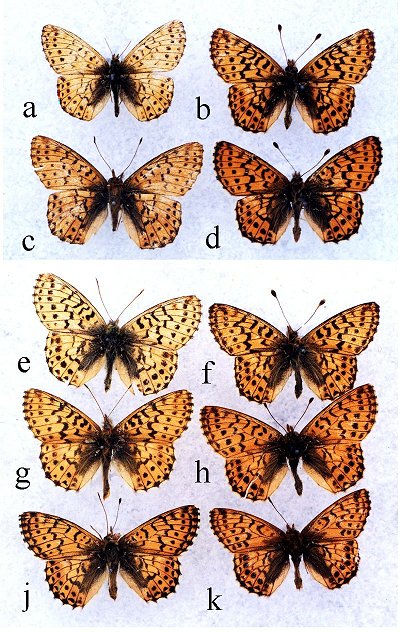
Fig.3. Boloria pales roddi, ssp. n.. Harpe of the genitalia of the male paratype originating from the Yustyd River at village Ak-Tal, 14th July 1959 (A. Cherepanov).
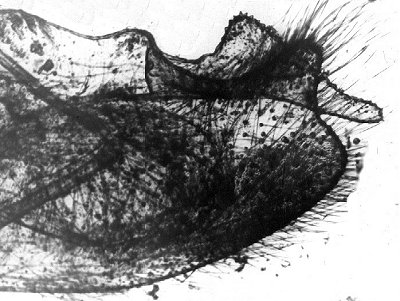
NOTE: The following figures were not published.
Fig. 4. Boloria pales roddi, ssp. n. Variation of the wing underside among male paratypes. The specimens and lettering correspond to those on Fig. 2.
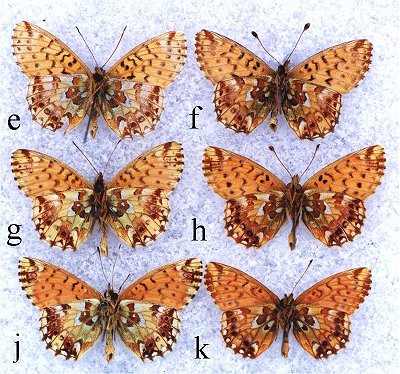
Fig. 5. Boloria pales roddi, ssp. n. Variation of the wing pattern among female paratypes. a, c, Altai, Dzhazator, 15/VII 1994 (R. Yakovlev); b, d, East Kazakhstan, Belaya BerelÒ River, 24th July 1987 (O. Kosterin)
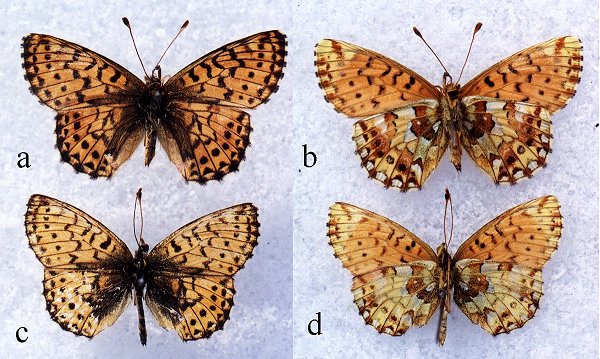
Fig. 6. Boloria pales roddi, ssp. n. A male in Nature. The Dzhazator River, 19/VII 1998 [not included into the actual publication]
